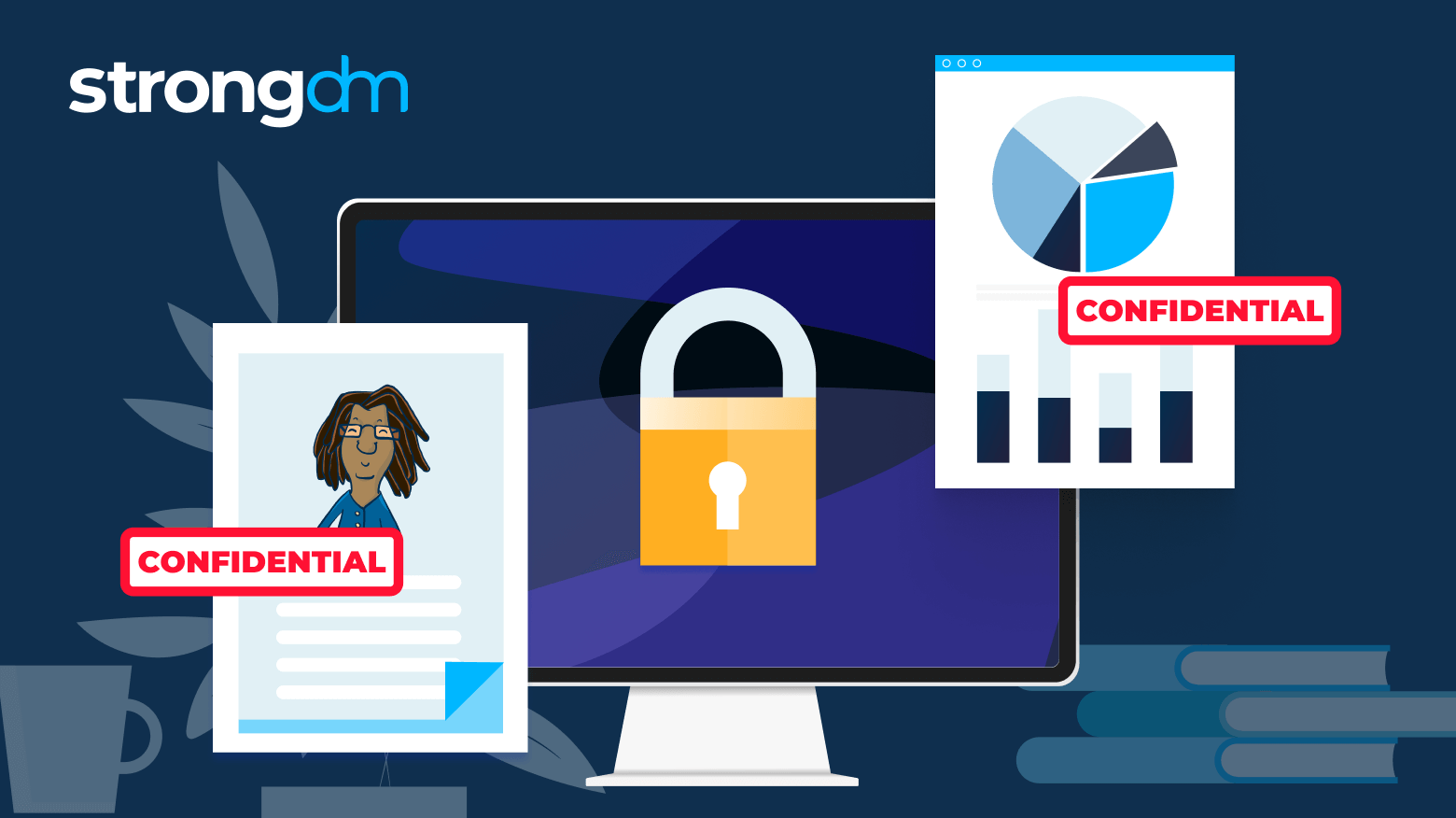

Written by
Schuyler BrownLast updated on:
July 7, 2023Reading time:
Contents
Built for Security. Loved by Devs.
- Free Trial — No Credit Card Needed
- Full Access to All Features
- Trusted by the Fortune 100, early startups, and everyone in between
Summary: In this article, we cover the sensitive data definition and the main risks associated with it. You'll see real sensitive information examples and learn how sensitive data differs from personal data. By the end of this article, you'll understand what data is sensitive and how to protect it against cyber risks and exposures.
What is Sensitive Data?
Sensitive data is information stored, processed, or managed by an individual or organization that is confidential and only accessible to authorized users with proper permission, privileges, or clearance to view it.
This type of information is considered sensitive because of the ramifications that could occur if it were in the wrong hands. Per the definition, unauthorized sensitive data exposure could either cause financial loss to companies, compromise an entity's security, affect someone's privacy, or diminish an organization's competitive advantage.
Sensitive Data Examples
Various types of sensitive data could cause tremendous harm to a person, business, or government agency if compromised. Here are some common examples of sensitive data.
Financial information
Information regarding an entity's wealth and income status or financial account data. This includes bank account and routing numbers, credit/debit card data defined by the Payment Card Industry Data Security Standard (PCI DSS), credit history records, and tax filings. Financial information exposure could risk financial loss or identity theft to someone if compromised.
Protected health information (PHI)
Any information defined by the Health Insurance Portability and Accountability Act (HIPAA), such as a person's health status, conditions, care, treatments, and health insurance-related information. If sensitive PHI were compromised, the victim's privacy would be in jeopardy.
Credential data
Information needed to access a system, application, device, or physical location, such as usernames, passwords, and personal identification numbers (PINs). It also includes data stored in physical authentication devices such as keycards and fobs and biometric data obtained by facial or fingerprint scans. Credential theft would compromise information security and privacy.
Customer information
Customer data such as names, addresses, web-browsing activity, and contact information like phone numbers and email addresses that do not include their financial data, PHI, or credentials. Failure to maintain customer privacy could result in regulatory fines and lawsuits against businesses managing their information.
Trade, proprietary, and government information
Information that provides and maintains an advantage to a business or government entity, such as intellectual property, military secrets, or business intelligence data. If compromised by an adversary or competitor, the victim would risk losing their competitive advantage within the market or in geopolitical and military conflicts.
Sensitive Data vs. Personal Data
Personal data, often called personally identifiable information (PII), is information that can be uniquely used to identify or verify a person or organization. Personal data can be either sensitive or non-sensitive. For example, names and phone numbers can easily be found in public records, and it would be difficult for a malicious actor to cause harm to an individual with this information alone. Alternatively, a person’s social security number can be used to steal their identity and is therefore considered sensitive PII.
Examples of PII:
| Sensitive PII | Non-sensitive PII |
| Bank account/routing numbers | First and last names |
| Social security numbers (SSN) | Email addresses |
| Drivers license numbers | Mailing addresses |
| Federal tax ID and employer identification numbers (EIN) | Phone numbers |
| Health insurance policy/member numbers | Social media profile names |
Sensitive Data Security Risks
Because of the potential value obtained by stealing sensitive data, cybercriminals and adversaries target it for financial or strategic gain—making sensitive data a considerable risk to organizations hosting, storing, or transmitting it. For instance, a malicious actor could use sensitive financial information to make large-scale purchases or a set of competitor insider intelligence data to incorporate into their business model to increase their market share.
When referring to sensitive credential information, hackers love using phishing scams or password-based attacks to acquire usernames and passwords. Once successful, they can breach applications and systems to extract other sensitive data or shut down operations entirely with a denial of services (DoS) attack or ransomware.
There is also the issue of modern-day practices for managing sensitive information. Most organizations today use cloud services entirely or through a hybrid model, often plagued with preventable key misconfigurations and user errors. These cause 99% of cloud breaches, a critical issue when 36% of organizations store unencrypted sensitive information in their cloud environment.
The education sector heavily relies on cloud storage for sensitive information, which has put a massive target on their backs. Nearly 47% of educational institutions suffered a cyber attack against their cloud infrastructure in 2021, in which 65% had been storing the PII of their customers.
Legal risks of sensitive data
In addition to the security implications, states and countries are continuously adding more regulations and security requirements for businesses managing sensitive data—specifically when it's the data of their customers or users. For example, the General Data Protection Regulation (GDPR) law of 2016 mandates data protection and consumer privacy requirements for European customers. Similarly, the California Consumer Privacy Act (CCPA) issues more control, transparency, and privacy protection for California residents’ data.
Failure to comply can result in hefty fines and lawsuits against the firm. Many of these regulations and standards outline security controls such as utilizing encryption, corporate governance policies like appointing a dedicated data-security officer, and notification requirements like informing customers of a breach within a certain time frame.
How to Protect Sensitive Data Against Exposures
Protecting sensitive data against leaks, theft, or unauthorized access requires a proactive system of sensitive data discovery by identifying sensitive data and where it is stored and then deploying protective security controls and processes.
First, establish data sensitivity classifications and criteria for what qualifies as sensitive data compared to nonsensitive information, such as content found in public records, social media pages, or a website. Sensitive data will be anything someone absolutely does not want unauthorized individuals seeing because of the financial, security, legal, or privacy impact that could occur.
Next, assess and document all the locations, resources, and data centers storing all the information that’s qualified as sensitive and determine all the users who have access to those network components. Evaluate potential vulnerabilities, risks, and most likely threats to those particular assets to establish a game plan of solutions to implement.
Protective security solutions
As organizations look to enhance their cybersecurity and sensitive data management program with data security and data loss prevention (DLP) solutions, consider some of the protective measures they can take:
- Utilize non-disclosure agreements (NDAs): Employee contractual NDAs help mitigate liability and hold those accountable for malicious acts of leaking or stealing essential information.
- Practice least privilege: The principle of least privilege minimizes access to sensitive data and resources by restricting access and enforcing authentication only to those who need it to fulfill their job duties.
- Require data encryption: Providing software tools and implementing company encryption policies gives an extra layer of security and makes information unreadable to unauthorized users—protecting data in motion, use, or at rest even if a hacker breaches a network.
- Sponsor security awareness training: Provide training to employees and users regarding how to spot and avoid phishing scams that would ultimately lead to sensitive data disclosure or exposure if the scammer successfully tricked a negligent employee.
- Patch misconfigured software: Misconfigured cloud infrastructure and applications are significant security gaps that give hackers an easy compromisable vulnerability. Regularly patch and update all software to avoid zero-day attacks and sensitive data breaches.
How StrongDM Makes Protecting Sensitive Data Easy
StrongDM ensures that only authorized users have secure access to sensitive data systems. The StrongDM platform includes granular permission management to enforce least-privilege access to network resources, one-click onboarding for provisioning, and the option for temporary user access to sensitive information. There's also a central command of authentication enforcement that will integrate with an enterprise’s preferred identity provider and federation service.
Security operations teams can integrate all technology resources housing and processing sensitive data, including databases, servers, clusters, web applications, and cloud data centers, for complete system visibility. The segmented access control, user verification management, and non-stop observability offered by StrongDM allow enterprises to enforce Zero Trust Network Access and a modern way to secure their sensitive data.
Secure Your Sensitive Data with StrongDM
While sensitive data such as customer, financial, access credentials, or proprietary information is essential to a business's success, its mishandling can put organizations at significant risk of loss. From legal liability claims, and operational slow down, to a lost competitive advantage, firms can ultimately find themselves in a position of diminished growth potential and poor financial performance due to a sensitive data compromise.
StrongDM helps businesses maintain sensitive data protection through privileged access control to sensitive information systems and careful management of user authentication processes. Additionally, StrongDM provides security teams and administrators with comprehensive observability of their technology stack and infrastructure by integrating resource event and user activity data into one central interface.
Ready to get started? Get a glimpse of our infrastructure access management solution today with our 14-day StrongDM free trial.
Next Steps
StrongDM unifies access management across databases, servers, clusters, and more—for IT, security, and DevOps teams.
- Learn how StrongDM works
- Book a personalized demo
- Start your free StrongDM trial


About the Author
Schuyler Brown, Chairman of the Board, began working with startups as one of the first employees at Cross Commerce Media. Since then, he has worked at the venture capital firms DFJ Gotham and High Peaks Venture Partners. He is also the host of Founders@Fail and author of Inc.com's "Failing Forward" column, where he interviews veteran entrepreneurs about the bumps, bruises, and reality of life in the startup trenches. His leadership philosophy: be humble enough to realize you don’t know everything and curious enough to want to learn more. He holds a B.A. and M.B.A. from Columbia University. To contact Schuyler, visit him on LinkedIn.
You May Also Like




